管理信息系统 课程设计
Posted wangze019
tags:
篇首语:本文由小常识网(cha138.com)小编为大家整理,主要介绍了管理信息系统 课程设计相关的知识,希望对你有一定的参考价值。
系统概要说明
本系统主要对于不同种类的电影,一些用户对于这些电影的评价,我们可以看待不同的用户对于不同种类的电影的不同,用户可以对于一些别人发布的影评进行评论,就好像两个人交流一样,对于发表的电影的赏析,进行交流,可以更好的让用户去了解这些视频。也可以发表自己不同的建议,就像两个人在面对面的交流一样。一些对电影喜欢的人可以更好的去了解电影的评价,和一些自己兴趣爱好相同的人进行心得的交流。
网站结构设计
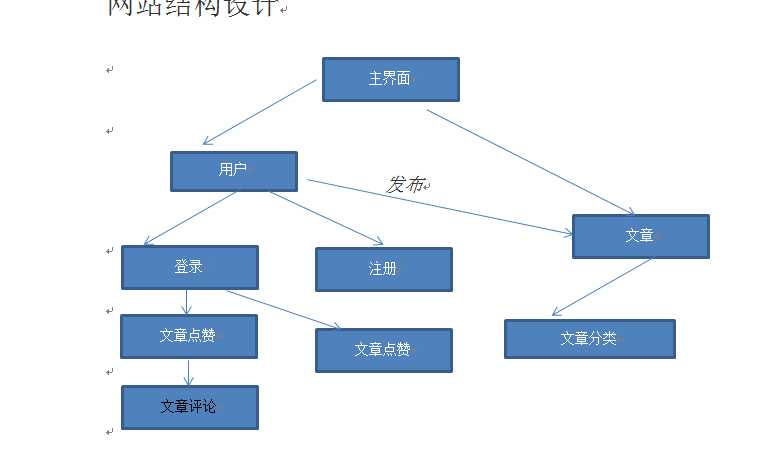
模块详细设计
首页
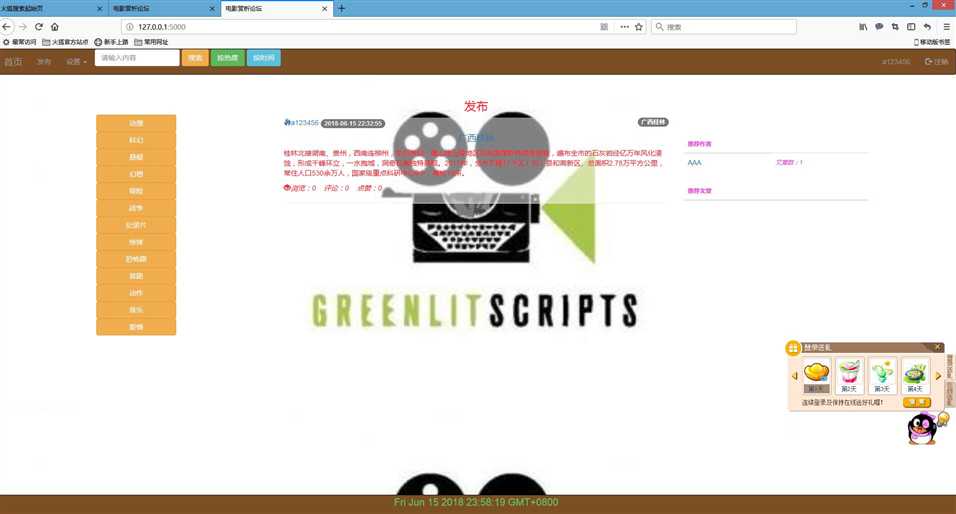
登录
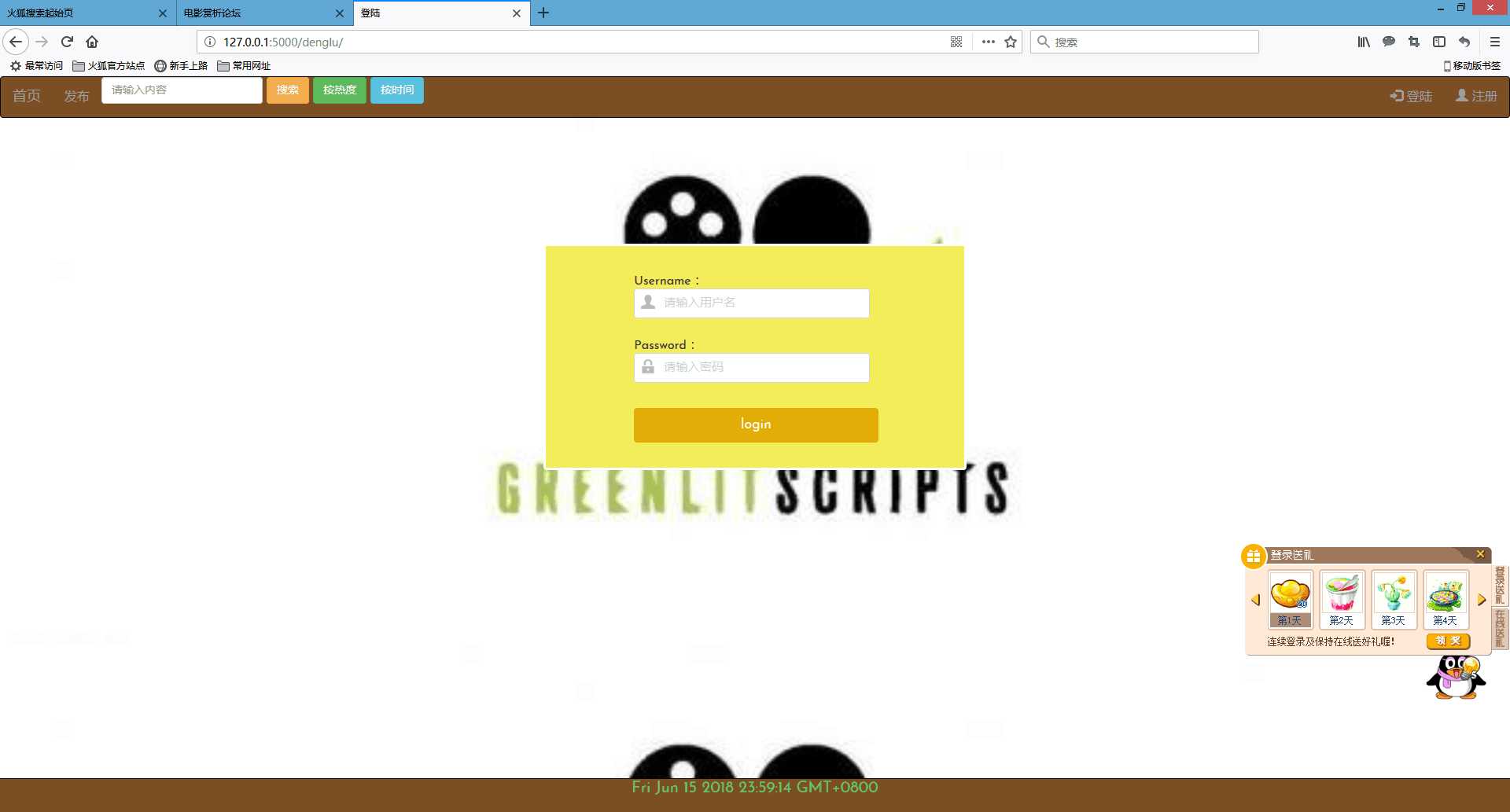
注册
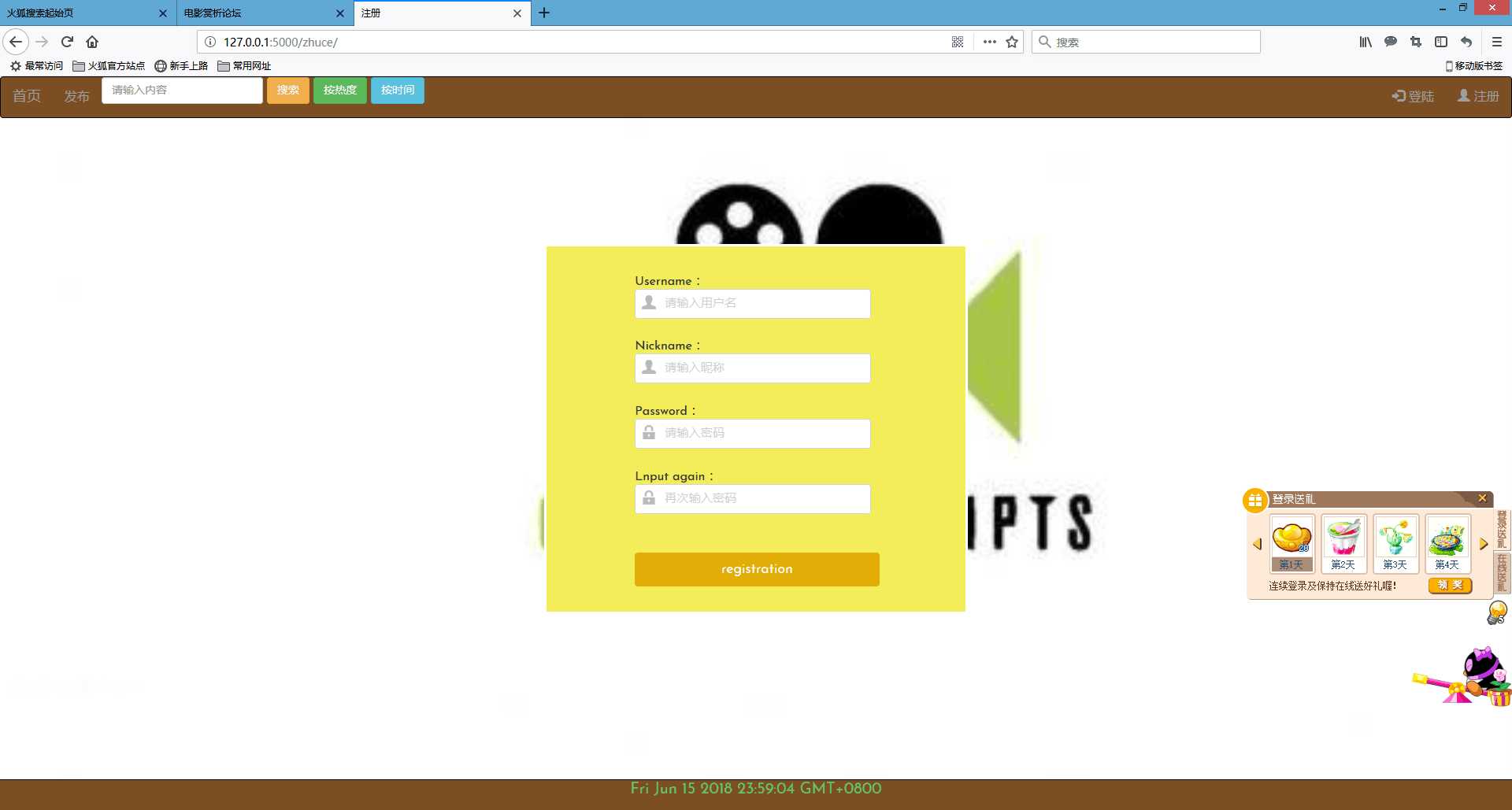
修改
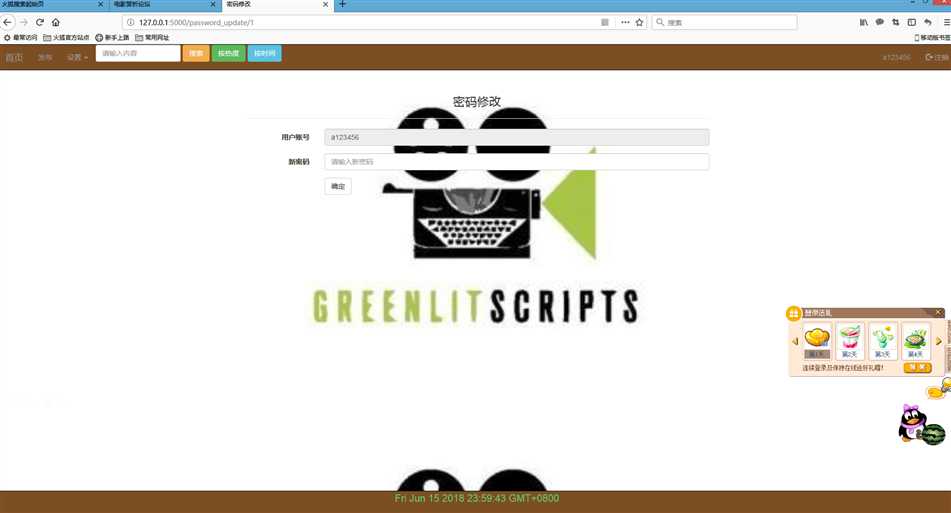
个人中心
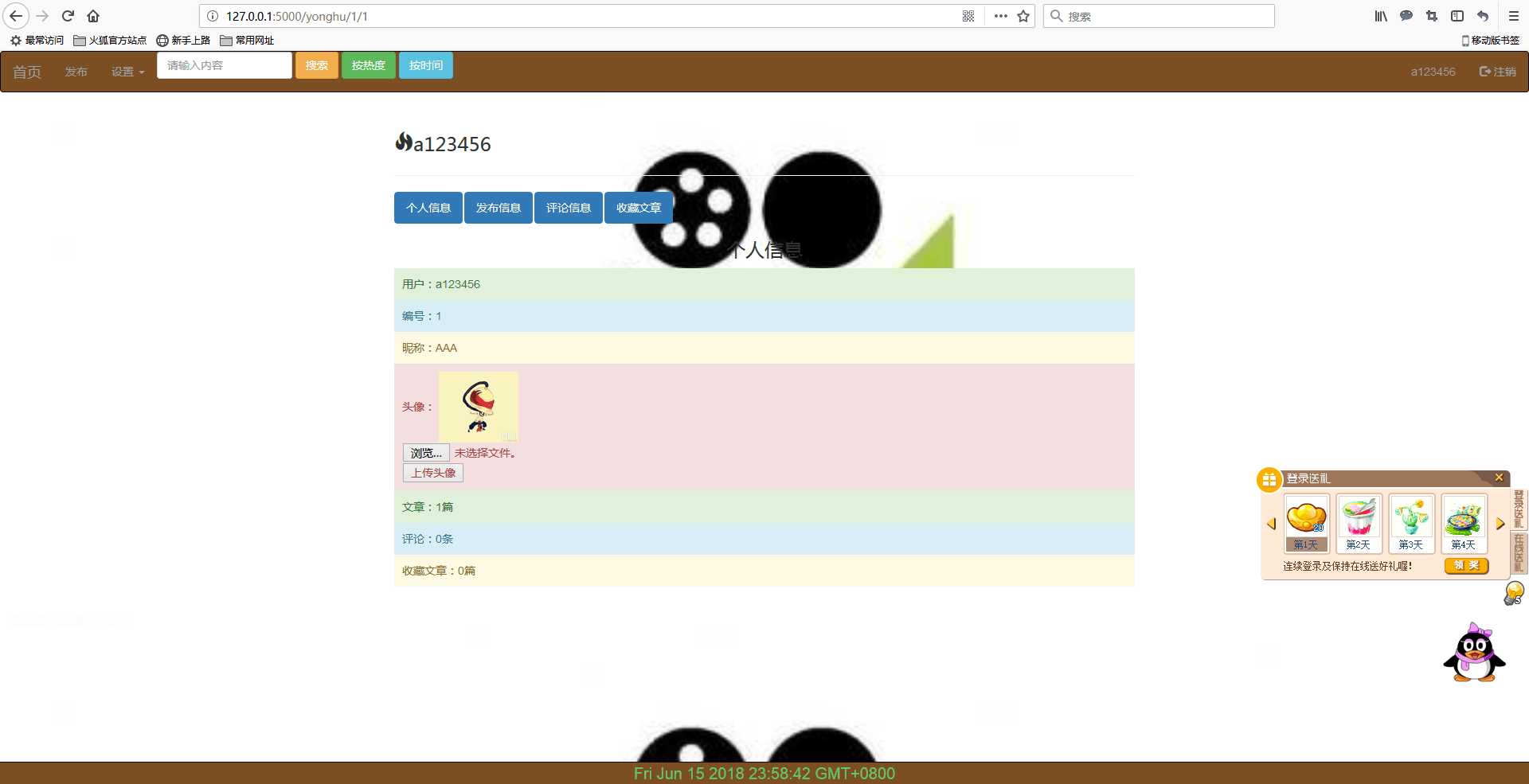
发布
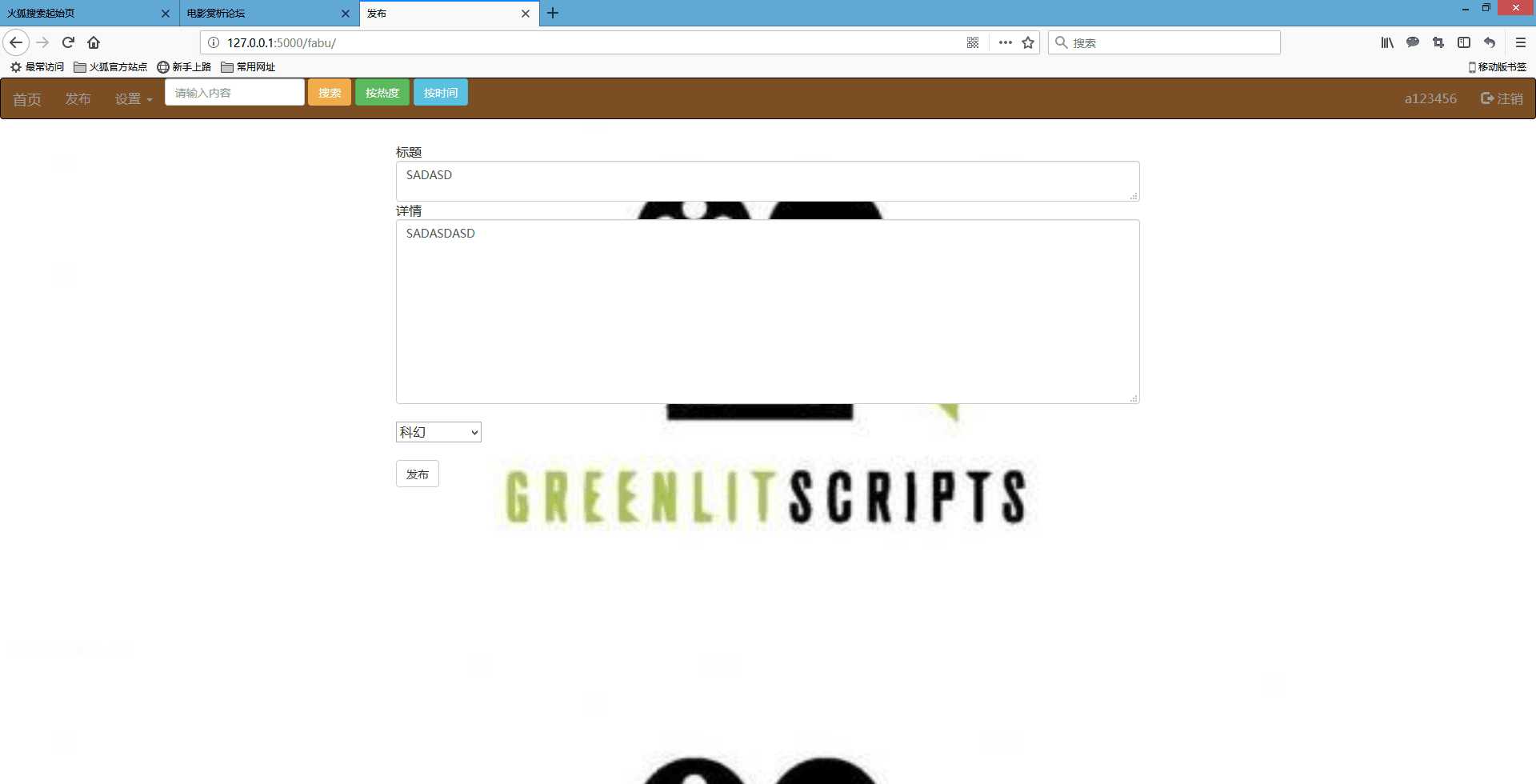
评论
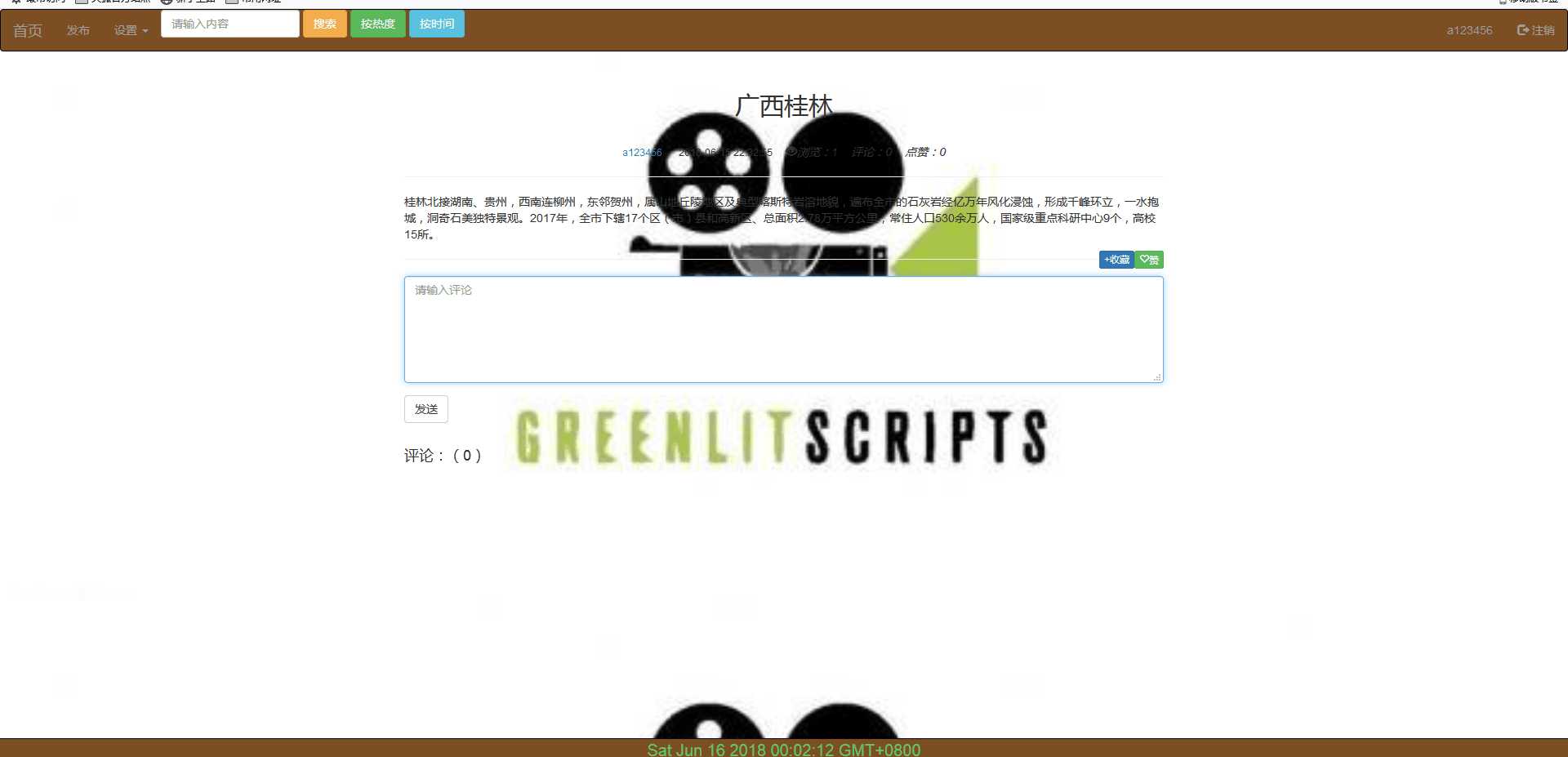
数据库设计
数据库的设计,我们的用户表,用户表的建立,包括有用户名和密码,还有用户的昵称,和用户的图片。
class User(db.Model):
__tablename__ = ‘user‘ # 类对应的表名user
id = db.Column(db.Integer, primary_key=True, autoincrement=True)
username = db.Column(db.String(20), nullable=False)
_password = db.Column(db.String(200), nullable=False)
nickname = db.Column(db.String(20), nullable=True)
img = db.Column(db.String(100),default=None)
文章表:标题,内容,和发布时间,时间是可以根据创建的时候自动更新的。文章的类型,文章的作者。
class Fabu(db.Model):
# 问答
__tablename__ = ‘fabu‘
id = db.Column(db.Integer, primary_key=True, autoincrement=True)
title = db.Column(db.String(100), nullable=False)
detail = db.Column(db.Text, nullable=False)
leixing = db.Column(db.String(20), nullable=True)
creat_time = db.Column(db.DateTime, default=datetime.now)
author_id = db.Column(db.Integer, db.ForeignKey(‘user.id‘))
评论表:作者的名称,评论的内容,评论的时间,评论的作者
class Comment(db.Model): # 评论
__tablename__ = ‘comment‘
id = db.Column(db.Integer, primary_key=True, autoincrement=True)
author_id = db.Column(db.Integer,
db.ForeignKey(‘user.id‘))
fabu_id = db.Column(db.Integer,
db.ForeignKey(‘fabu.id‘))
creat_time = db.Column(db.DateTime, default=datetime.now)
detail = db.Column(db.Text, nullable=False)
fabu = db.relationship(‘Fabu‘,
backref=db.backref(‘comments‘, order_by=creat_time.desc)) # order_by=creat_time.desc按时间降序
author = db.relationship(‘User‘, backref=db.backref(‘comments‘))
系统实现的关键算法与数据结构
算法是对于一些功能的实现进行的,通过后台的运行来建立的一系列的运算,对于一些数据的传输,和算法对于一些功能的实现,比如对于一些文章进行分类和排序,,对于用户的密码进行分析,对用户的密码进行加密。
方法实现代码如下:
from flask import Flask, render_template, request, redirect, url_for, session from flask_sqlalchemy import SQLAlchemy import config,os from functools import wraps from datetime import datetime from sqlalchemy import or_, and_ from werkzeug.security import generate_password_hash, check_password_hash app = Flask(__name__) # 创建Flask对象 app.config.from_object(config) # 关联config.py文件进来 db = SQLAlchemy(app) # 建立和数据库的关系映射 class User(db.Model): # 创建类User __tablename__ = ‘user‘ # 类对应的表名user id = db.Column(db.Integer, primary_key=True, autoincrement=True) # autoincrement自增长 username = db.Column(db.String(20), nullable=False) # nullable是否为空 _password = db.Column(db.String(200), nullable=False) # 密码加密内部使用 nickname = db.Column(db.String(20), nullable=True) img = db.Column(db.String(100),default=None) @property # 定义函数,需要用属性时可以用函数代替 def password(self): # 密码加密外部使用 return self._password @password.setter def password(self, row_password): # 密码进来时进行加密,generate_password_hash是一个密码加盐哈希函数,生成的哈希值可通过check_password_hash()进行验证。 self._password = generate_password_hash(row_password) def check_password(self, row_password): # check_password_hash函数用于验证经过generate_password_hash哈希的密码。若密码匹配,则返回真,否则返回假。 result = check_password_hash(self._password, row_password) return result class Fabu(db.Model): # 问答 __tablename__ = ‘fabu‘ id = db.Column(db.Integer, primary_key=True, autoincrement=True) title = db.Column(db.String(100), nullable=False) detail = db.Column(db.Text, nullable=False) leixing = db.Column(db.String(20), nullable=True) creat_time = db.Column(db.DateTime, default=datetime.now) # 提交时间会自己赋值 author_id = db.Column(db.Integer, db.ForeignKey(‘user.id‘)) # 数据类型是db.Integer,db.ForeignKey参数指定外键是哪个表中哪个id author = db.relationship(‘User‘, backref=db.backref(‘fabu‘)) # 建立关联,其author属性将返回与问答相关联的用户实例,相当于数据库中的表连接 # 第一个参数表明这个关系的另一端是哪个类,第二个参数backref,将向User类中添加一个fabu属性,从而定义反向关系,这一属性可访问Fabu类,获取的是模型对象 yuedu = db.Column(db.Integer, nullable=False) class Comment(db.Model): # 评论 __tablename__ = ‘comment‘ id = db.Column(db.Integer, primary_key=True, autoincrement=True) author_id = db.Column(db.Integer, db.ForeignKey(‘user.id‘)) fabu_id = db.Column(db.Integer, db.ForeignKey(‘fabu.id‘)) creat_time = db.Column(db.DateTime, default=datetime.now) detail = db.Column(db.Text, nullable=False) fabu = db.relationship(‘Fabu‘, backref=db.backref(‘comments‘, order_by=creat_time.desc)) # order_by=creat_time.desc按时间降序 author = db.relationship(‘User‘, backref=db.backref(‘comments‘)) class Shoucang(db.Model): # 收藏 __tablename__ = ‘shoucang‘ id = db.Column(db.Integer, primary_key=True, autoincrement=True) author_id = db.Column(db.Integer, db.ForeignKey(‘user.id‘)) fabu_id = db.Column(db.Integer, db.ForeignKey(‘fabu.id‘)) fabu = db.relationship(‘Fabu‘, backref=db.backref(‘shoucangs‘)) author = db.relationship(‘User‘, backref=db.backref(‘shoucangs‘)) class Dianzang(db.Model): # 点赞 __tablename__ = ‘dianzang‘ id = db.Column(db.Integer, primary_key=True, autoincrement=True) author_id = db.Column(db.Integer, db.ForeignKey(‘user.id‘)) fabu_id = db.Column(db.Integer, db.ForeignKey(‘fabu.id‘)) fabu = db.relationship(‘Fabu‘, backref=db.backref(‘dianzangs‘)) author = db.relationship(‘User‘, backref=db.backref(‘dianzangs‘)) # db.create_all() # 测试是否连接成功 ‘‘‘ # 插入功能 user = User(username=‘15‘,password=‘12‘) db.session.add(user) db.session.commit() # 查询功能 user=User.query.filter(User.username=="15").first() print(user.username,user.password) # 修改功能 user=User.query.filter(User.username=="15").first() user.password=‘888‘ db.session.commit() # 删除功能 user=User.query.filter(User.username=="15").first() db.session.delete(user) db.session.commit() ‘‘‘ # session会话连接 # filter()过滤器 # route制定路径和函数之间的关系 # def定义一个变量 # 跳转首页。 @app.route(‘/‘) def daohang(): pl = request.args.get(‘pl‘) # 接收顺序排列的关键词,接收不到就按时间排列 if pl == ‘按热度‘: context = { ‘fabus‘: Fabu.query.order_by(‘-yuedu‘).all(), ‘author‘: User.query.all(), ‘ydfabu‘: Fabu.query.filter(Fabu.yuedu > 5).all() # 当发布的文章阅读量大于多少时取出这些文章,显示在首页的推荐文章 # order_by(‘-creat_time‘)按时间降序排列,Fabu.query.all()查出了Fabu类的所有元组 } return render_template(‘daohang.html‘, **context) else: context = { ‘fabus‘: Fabu.query.order_by(‘-creat_time‘).all(), ‘author‘: User.query.all(), ‘ydfabu‘: Fabu.query.filter(Fabu.yuedu > 5).all() # 当发布的文章阅读量大于多少时取出这些文章,显示在首页的推荐文章 # order_by(‘-creat_time‘)按时间降序排列,Fabu.query.all()查出了Fabu类的所有元组 } return render_template(‘daohang.html‘, **context) # 跳转测试。 @app.route(‘/lin/‘) def lin(): return ‘lin‘ # 跳转登陆。 @app.route(‘/denglu/‘, methods=[‘GET‘, ‘POST‘]) # methods定义它有两种请求方式 def denglu(): if request.method == ‘GET‘: return render_template(‘denglu.html‘) else: username = request.form.get(‘user‘) # post请求模式,安排对象接收数据 password = request.form.get(‘pass‘) user = User.query.filter(User.username == username).first() # 作查询,并判断 if user: # 判断用户名 if user.check_password(password): # 判断密码 session[‘user‘] = username # 利用session添加传回来的值username session[‘user_id‘] = user.id session.permanent = True # 设置session过期的时间 return redirect(url_for(‘daohang‘)) else: return u‘用户密码错误‘ else: return u‘用户不存在,请先注册‘ # 跳转密码修改页。 @app.route(‘/password_update/<user_id>‘) def password_update(user_id): users = User.query.filter(User.id == user_id).first() # 查询出要修改密码的该用户 return render_template(‘password_update.html‘, users=users) # 跳转修改密码后接受数据。 @app.route(‘/password_update1/‘, methods=[‘POST‘]) def password_update1(): username = request.form.get(‘username‘) # 接收username的值,知道要修改的是哪个用户 password = request.form.get(‘password‘) users = User.query.filter(User.username == username).first() # 查询出要修改用户的整条信息 users.password = password # 执行修改 db.session.commit() return redirect(url_for(‘yonghu‘, username_id=users.id, tag=‘1‘)) @app.context_processor # 上下文处理器,定义变量然后在所有模板中都可以调用,类似idea中的model def mycontext(): user = session.get(‘user‘) user_id = session.get(‘user_id‘) if user: return {‘sessionusername‘: user, ‘sessionuserid‘: user_id} # 包装到username,在所有html模板中可调用 else: return {} # 返回空字典,因为返回结果必须是dict # 跳转注销。 @app.route(‘/logout‘) def logout(): session.clear() # 注销时删除所有session return redirect(url_for(‘daohang‘)) # 跳转注册。 @app.route(‘/zhuce/‘, methods=[‘GET‘, ‘POST‘]) # methods定义它有两种请求方式,因为它在表单的请求是post,类似我们在idea中的sava请求模式 def zhuce(): if request.method == ‘GET‘: return render_template(‘zhuce.html‘) else: username = request.form.get(‘user‘) # post请求模式,安排对象接收数据 password = request.form.get(‘pass‘) nickname = request.form.get(‘nickname‘) user = User.query.filter(User.username == username).first() # 作查询,并判断 if user: return u‘该用户已存在‘ else: user = User(username=username, password=password, nickname=nickname) # 将对象接收的数据赋到User类中,即存到数据库 db.session.add(user) # 执行操作 db.session.commit() return redirect(url_for(‘denglu‘)) # redirect重定向 # 跳转某页面之前先进行登录。定义decorator可以增强函数功能,装饰器本身是函数,入参是函数,返回值也是函数 def loginFirst(fabu): @wraps(fabu) # 加上wraps,它可以保留原有函数的__name__,docstring def wrapper(*args, **kwargs): # 定义wrapper函数将其返回,用*args, **kwargs把原函数的参数进行传递 if session.get(‘user‘): # 只有经过登陆,session才能记住并get到值 return fabu(*args, **kwargs) else: return redirect(url_for(‘denglu‘)) return wrapper # 跳转图片。 @app.route(‘/tupian/‘) def tupian(): return render_template(‘tupian.html‘) # 跳转发布。 @app.route(‘/fabu/‘, methods=[‘GET‘, ‘POST‘]) # methods定义它有两种请求方式 @loginFirst # 将decorator定义的增强函数放在待增强函数定义的上面 def fabu(): if request.method == ‘GET‘: return render_template(‘fabu.html‘) else: title = request.form.get(‘title‘) # post请求模式,安排对象接收数据 detail = request.form.get(‘detail‘) leixing = request.form.get(‘leixing‘) yuedu = 0 author_id = User.query.filter( User.username == session.get(‘user‘)).first().id # 将session get到的user进行查询并取出id放到外键author_id中 fabu = Fabu(title=title, detail=detail, author_id=author_id, leixing=leixing, yuedu=yuedu) # 将对象接收的数据赋到Fabu类中,即存到数据库 db.session.add(fabu) # 执行操作 db.session.commit() # 提交到数据库 return redirect(url_for(‘daohang‘)) # redirect重定向 # 跳转发布详情 @app.route(‘/fabuview/<fabu_id>‘) # 和idea的update一样,将id带到控制器 def fabuview(fabu_id): yes = Shoucang.query.filter( # yes用在用户详情页判断是否已收藏的按钮 and_( Shoucang.author_id == session.get(‘user_id‘), Shoucang.fabu_id == fabu_id ) ).first() dzyes = Dianzang.query.filter( # dzyes用在用户详情页判断是否已点赞的按钮 and_( Dianzang.author_id == session.get(‘user_id‘), Dianzang.fabu_id == fabu_id ) ).first() fa = Fabu.query.filter(Fabu.id == fabu_id).first() # 根据主页带回来的id查询出整条元组记录,丢进fa comments = Comment.query.filter(Comment.fabu_id == fabu_id).all() # 根据带回来的Fabu的id在Comment查询出所有评论 fa.yuedu = fa.yuedu + 1 # 定义浏览功能,每次进去详情页,浏览次数加1 db.session.commit() return render_template(‘fabuview.html‘, fa=fa, comments=comments, yes=yes, dzyes=dzyes) # 把值fa丢进键fa,在fabuview.html页面调用 # 方法二: # fabu={ # ‘fa‘:Fabu.query.filter(Fabu.id == fabu_id).first() # } # return render_template(‘fabuview.html‘,**fabu) # 跳转评论。 @app.route(‘/comment/‘, methods=[‘POST‘]) @loginFirst # 装饰器,跳转某页面之前先进行登录 def comment(): detail = request.form.get(‘pinglun‘) # post请求模式,安排对象接收数据 author_id = User.query.filter(User.username == session.get(‘user‘)).first().id fabu_id = request.form.get(‘fa_id‘) comment = Comment(detail=detail, author_id=author_id, fabu_id=fabu_id) # 将对象接收的数据赋到Comment类中,即存到数据库 db.session.add(comment) # 执行操作 db.session.commit() # 提交到数据库 return redirect(url_for(‘fabuview‘, fabu_id=fabu_id)) # 重定向到fabuview请求时要带fabu_id # 跳转用户详情 @app.route(‘/yonghu/<username_id>/<tag>‘) # 为了把页面分开,我们在html页面传了一个tag参数 def yonghu(username_id, tag): user = User.query.filter(User.id == username_id).first() shoucang = Shoucang.query.filter(Shoucang.author_id == username_id).all() context = { ‘userid‘: user.id, ‘username‘: user.username, ‘nickname‘: user.nickname, ‘fabus‘: user.fabu, ‘comments‘: user.comments, ‘shoucang‘: shoucang, ‘img‘:user.img } # 根据tag的不同去到不同页面,一个请求跳转3个不同页面 if tag == ‘1‘: return render_template(‘yonghu1.html‘, **context) elif tag == ‘2‘: return render_template(‘yonghu2.html‘, **context) elif tag == ‘3‘: return render_template(‘yonghu3.html‘, **context) else: return render_template(‘yonghu4.html‘, **context) # @app.route(‘/yonghu2/<username_id>‘) # def yonghu2(username_id): # user = User.query.filter(User.id == username_id).first() # context = { # ‘userid‘:user.id, # ‘username‘:user.username, # ‘fabus‘:user.fabu, # ‘comments‘:user.comments # } # return render_template(‘yonghu2.html‘,**context) # # # @app.route(‘/yonghu3/<username_id>‘) # def yonghu3(username_id): # user = User.query.filter(User.id == username_id).first() # context = { # ‘userid‘:user.id, # ‘username‘:user.username, # ‘fabus‘:user.fabu, # ‘comments‘:user.comments # } # return render_template(‘yonghu3.html‘,**context) # 跳转首页搜索 @app.route(‘/search/‘) def search(): sousuo = request.args.get(‘sousuo‘) # args获取关键字,区别form author = User.query.all() ydfabu = Fabu.query.filter(Fabu.yuedu > 5).all() fabus = Fabu.query.filter( or_( # 两种查询条件 Fabu.title.contains(sousuo), # contains模糊查 Fabu.detail.contains(sousuo) ) ).order_by(‘-creat_time‘) return render_template(‘daohang.html‘, fabus=fabus, author=author, ydfabu=ydfabu) # fabus要和原首页数据模型一样 # 跳转高级分类查询 @app.route(‘/fenlei/‘) def fenlei(): fenlei = request.args.get(‘fenlei‘) # args获取关键字,区别form author = User.query.all() ydfabu = Fabu.query.filter(Fabu.yuedu > 5).all() fenlei_fabus = Fabu.query.filter( or_( # 两种查询条件 # Fabu.title.contains(fenlei), # contains模糊查 Fabu.leixing.contains(fenlei), # Fabu.creat_time.contains(fenlei) ) ).order_by(‘-creat_time‘) return render_template(‘daohang.html‘, fabus=fenlei_fabus, author=author, ydfabu=ydfabu) # fabus要和原首页数据模型一样 # 跳转文章收藏 @app.route(‘/shoucang/‘, methods=[‘POST‘]) @loginFirst def shoucang(): scfabu_id = request.form.get(‘scfabu_id‘) scuser_id = request.form.get(‘scuser_id‘) shoucang = Shoucang(fabu_id=scfabu_id, author_id=scuser_id) db.session.add(shoucang) # 执行操作 db.session.commit() # 提交到数据库 return redirect(url_for(‘fabuview‘, fabu_id=scfabu_id)) # 跳转文章点赞 @app.route(‘/dianzang/‘, methods=[‘POST‘]) @loginFirst def dianzang(): dzfabu_id = request.form.get(‘dzfabu_id‘) dzuser_id = request.form.get(‘dzuser_id‘) dianzang = Dianzang(fabu_id=dzfabu_id, author_id=dzuser_id) db.session.add(dianzang) # 执行操作 db.session.commit() # 提交到数据库 return redirect(url_for(‘fabuview‘, fabu_id=dzfabu_id)) #上传头像 @app.route(‘/uploadLogo/<user_id>‘, methods=[‘GET‘, ‘POST‘]) def uploadLogo(user_id): user = User.query.filter(User.id == user_id).first() f = request.files[‘logo‘] basepath = os.path.dirname(__file__) # 当前文件所在路径 upload_path = os.path.join(basepath, ‘static/img‘, f.filename) # 注意:没有的文件夹一定要先创建,不然会提示没有该路径 f.save(upload_path) user.img = ‘img/‘ + f.filename db.session.commit() return redirect(url_for(‘yonghu‘, username_id=user_id,tag=1)); if __name__ == ‘__main__‘: app.run(debug=True)
以上是关于管理信息系统 课程设计的主要内容,如果未能解决你的问题,请参考以下文章
20155234 2017-2018-1《信息安全系统设计基础》课程总结